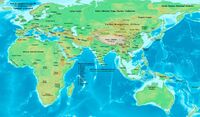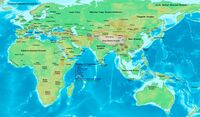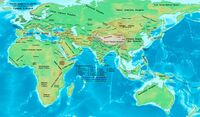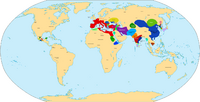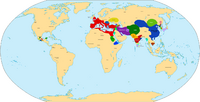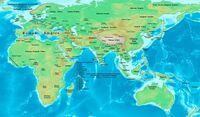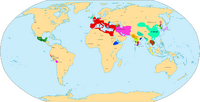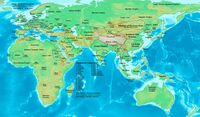Timeline of ancient history
Topic: History
 From HandWiki - Reading time: 17 min
From HandWiki - Reading time: 17 min
This timeline of ancient history lists historical events of the documented ancient past from the beginning of recorded history until the Early Middle Ages. Prior to this time period, prehistory civilizations were pre-literate and did not have written language.
Millennia: 4th millennium BC - 3rd millennium BC - 2nd millennium BC - 1st millennium BC - 1st millennium
Centuries: 34th BC - 33rd BC - 32nd BC - 31st BC - 30th BC - 29th BC - 28th BC - 27th BC - 26th BC - 25th BC - 24th BC - 23rd BC - 22nd BC - 21st BC - 20th BC - 19th BC - 18th BC - 17th BC - 16th BC - 15th BC - 14th BC - 13th BC - 12th BC - 11th BC - 10th BC - 9th BC - 8th BC - 7th BC - 6th BC - 5th BC - 4th BC - 3rd BC - 2nd BC - 1st BC - 1st AD - 2nd AD - 3rd AD - 4th AD
Early history
- Late 4th millennium BC: Sumerian cuneiform writing system[1][2] and Egyptian hieroglyphs are first used
- 3200 BC: Cycladic culture in Greece.
- 3200 BC: Caral-Supe civilization begins in Peru.
- 3200 BC: Rise of Proto-Elamite Civilization in Iran.
- 3200 BC: Skara Brae is built in Scotland.
- 3100 BC: First Dynasty of Egypt.[3]
- c. 3000 BC: Stonehenge construction begins. In its first version, it consisted of a circular ditch and bank, with 56 wooden posts.[4]
- c. 3000 BC: Cucuteni–Trypillia culture is established in Romania and Ukraine .
- 3000 BC: Jiroft culture begins in Iran.
- 3000 BC: First known use of papyrus by Egyptians.
- 3000 BC – 2500 BC: Earliest evidence of autochthonous iron production in West Africa.[5]
- 3000 BC – 2300 BC: The East African Pastoral neolithic culture builds East Africa's earliest and largest monumental cemetery at Lothagam North Pillar Site.[6]
- 3000 BC: Domestication of the horse in the Yamnaya culture.
- 2800 BC: Kot Diji phase of the Indus Valley Civilisation begins.
- 2800 BC: Longshan culture begins in China .
- 2700 BC: Minoan civilization ancient palace city Knossos reaches 80,000 inhabitants.
- 2700 BC: Rise of Elam in Iran.
- 2700 BC: The Old Kingdom begins in Egypt.
- 2600 BC: Oldest known surviving literature: Sumerian texts from Abu Salabikh, including the Instructions of Shuruppak and the Kesh temple hymn.[7][8][9][10]
- 2600 BC: Mature Harappan phase of the Indus Valley civilization (in present-day Pakistan and India ) begins.
- 2600 BC: Emergence of Mayan culture in the Yucatán Peninsula.
- 2560 BC: King Khufu completes the Great Pyramid of Giza. The Land of Punt in the Horn of Africa first appears in Egyptian records around this time.
- 2500 BC – 1500 BC: Kerma culture begins in Nubia.
- 2500 BC: The last mammoth population, on Wrangel Island in Siberia, goes extinct.
- Late 24th century BC: Akkadian Empire is founded, dating depends upon whether the Middle chronology or the Short chronology is used.[11]
- 2291 BC: Pharaoh Teti is thought to be the earliest known victim of assassination.[12]
- 2250 BC: Oldest known depiction of the Staff God, the oldest image of a god to be found in the Americas.
- 2200 BC – 2100 BC: 4.2-kiloyear event: a severe aridification phase, likely connected to a Bond event, which was registered throughout most of North Africa, Middle East and continental North America. Related droughts very likely caused the collapse of the Old Kingdom in Egypt and the Akkadian Empire in Mesopotamia.
- 2200 BC: Completion of Stonehenge.
- 2115 BC: Traditional date for the legendary foundation of Armenia by Hayk.[13][14]
- 2055 BC: The Middle Kingdom begins in Egypt.[15]
- 1900 BC: Erlitou culture begins in China.
- 1800 BC: Alphabetic writing emerges.
- 1800 BC: The Old Babylonian Epic of Gilgamesh constitutes the earliest complete version of that narrative.[16][17]
- 1780 BC: Oldest Record of Hammurabi's Code.
- c. 1750 BC: Mycenaean civilization begins in mainland Greece.
- 1700 BC – 1400 BC: The Proto-Sinaitic script is the oldest alphabet created in Egypt.
- 1700 BC: Indus Valley Civilization comes to an end but is continued by the Cemetery H culture; The beginning of Poverty Point culture in North America.
- 1600 BC: Minoan eruption destroys Akrotiri and causes damage to some Minoan sites in eastern Crete.[18][19][20]
- 1600 BC: The beginning of Shang dynasty in China;[21] evidence of a fully developed writing system, see Oracle bone script.
- c. 1550 BC: The New Kingdom begins in Egypt.[22]
- 1500 BC: Composition of the Rigveda is completed.[23][24][25]
- 1500 BC – 400 BC: Olmec civilization flourishes in Pre-Columbian Mexico, during Mesoamerica's Formative period.[26]
- c. 1400 BC: Oldest known song with notation.
- 1200 BC: The Hallstatt culture begins.
- 1200 BC – 1150 BC: Bronze Age collapse occurs in Southwestern Asia and in the Eastern Mediterranean region. This period is also the setting of the Iliad and the Odyssey epic poems (which were composed about four centuries later).
- c. 1180 BC: Disintegration of Hittite Empire.
- 1100 BC: Use of Iron spreads.
- 1050 BC: The Phoenician alphabet is created.
- 1046 BC: The Zhou force (led by King Wu of Zhou) overthrow the last king of Shang dynasty; Zhou dynasty established in China.
- 1000 BC: Nok culture begins in West Africa.
- 1000 BC: The second stream of Bantu expansion reaches the great lakes region of Africa, creating a major population centre.[27][28]
- 890 BC: Approximate date for the composition of the Iliad and the Odyssey.
- 814 BC: Foundation of Carthage by the Phoenicians in today known Tunisia.
- 800 BC: Rise of Ancient Greece city-states.
- 788 BC: Iron Age begins in Sungai Batu (Old Kedah).
- c. 785 BC: Rise of the Kingdom of Kush.
Classical antiquity
Classical antiquity is a broad term for a long period of cultural history centered on the Mediterranean Sea, comprising the interlocking civilizations of Ancient Greece and Ancient Rome. It refers to the timeframe of Ancient Greece and Ancient Rome.[29][30] Ancient history includes the recorded Greek history beginning in about 776 BC (First Olympiad). This coincides roughly with the traditional date of the founding of Rome in 753 BC and the beginning of the history of Rome.[31][32]
- 776 BC: First recorded Ancient Olympic Games.
- 771 BC: Spring and Autumn period begins in China; Zhou dynasty's power is diminishing; the era of the Hundred Schools of Thought.
- 753 BC: Founding of Rome (traditional date).
- 745 BC: Tiglath-Pileser III becomes the new king of Assyria. With time he conquers neighboring countries and turns Assyria into an empire.
- 728 BC: Rise of the Median Empire.
- 700 BC: The construction of Marib Dam in Arabia Felix, in modern Saudi Arabia and Yemen.
- 653 BC: Rise of Achaemenid dynasty.
- 650 BC – 550 BC: The Urewe culture dominates the African Great Lakes region. It was one of Africa's oldest iron smelting centres.[33][34]
- 612 BC: An alliance between the Babylonians, Medes, and Scythians succeeds in destroying Nineveh and causing subsequent fall of the Assyrian empire.
- 600 BC: Pandyan kingdom is founded in South India.
- 600 BC: Sixteen Mahajanapadas ("Great Realms" or "Great Kingdoms") emerge in India.
- 600 BC: Evidence of writing system appears in Oaxaca used by the Zapotec civilization.
- c. 600 BC: Rise of the Sao civilization near Lake Chad.
- 563 BC: Siddhartha Gautama (Buddha), founder of Buddhism is born as a prince of the Shakya clan, which ruled parts of Magadha, one of the Mahajanapadas.
- 551 BC: Confucius, founder of Confucianism, is born.
- 550 BC: Foundation of the Achaemenid Empire by Cyrus the Great.
- 549 BC: Mahavira, founder of Jainism, is born.
- 546 BC: Cyrus the Great overthrows Croesus, King of Lydia.
- 544 BC: Rise of Magadha as the dominant power under Bimbisara.
- 539 BC: The fall of the Neo-Babylonian Empire and liberation of the Jews by Cyrus the Great.
- 529 BC: Death of Cyrus the Great.
- 525 BC: Cambyses II of Persia conquers Ancient Egypt.
- c. 512 BC: Darius I (Darius the Great) of Persia, subjugates eastern Thrace, Macedonia submits voluntarily, and annexes the Libyan Kingdom, Persian Empire at largest extent.
- 509 BC: Expulsion of Lucius Tarquinius Superbus, founding of Roman Republic (traditional date).
- 508 BC: Athenian democracy instituted at the Republic of Athens.
- 500 BC: Panini standardizes the grammar and morphology of Sanskrit in the text Ashtadhyayi. Panini's standardized Sanskrit is known as Classical Sanskrit.
- 499 BC: King Aristagoras of Miletus incites all of Hellenic Asia Minor to rebel against the Persian Empire, beginning the Greco-Persian Wars.
- 490 BC: Greek city-states defeat Persian invasion at Battle of Marathon.
- 483 BC: Death of Gautama Buddha.
- 480 BC: Persian invasion of Greece by Xerxes I; Battles of Thermopylae and Salamis.
- 479 BC: Death of Confucius.
- 475 BC: Warring States period begins in China as the Zhou king became a mere figurehead; China is annexed by regional warlords.
- 470 BC / 469 BC: Birth of Socrates.
- 465 BC: Murder of Xerxes I.
- 460 BC: Birth of Democritus.
- 458 BC: The Oresteia by Aeschylus, the only surviving trilogy of ancient Greek plays, is performed.
- 449 BC: The Greco-Persian Wars end.
- 447 BC: Building of the Parthenon at Athens started.
- 432 BC: Construction of the Parthenon is completed.
- 431 BC: Beginning of the Peloponnesian War between the Greek city-states.
- 429 BC: Sophocles's play Oedipus Rex is first performed.
- 427 BC: Birth of Plato.
- 424 BC: Nanda dynasty comes to power in Magadha.
- 404 BC: End of the Peloponnesian War.
- 400 BC: Zapotec culture flourishes around city of Monte Albán.
- c. 400 BC: Rise of the Garamantes as an irrigation-based desert state in the Fezzan region of Libya.
- 399 BC: Death of Socrates.
- 384 BC: Birth of Aristotle.
- 370 BC: Death of Democritus.
- 331 BC: Alexander the Great defeats Darius III of Persia in the Battle of Gaugamela, completing his conquest of Persia.
- 326 BC: Alexander the Great defeats Indian king Porus in the Battle of the Hydaspes River.
- 323 BC: Death of Alexander the Great at Babylon.
- 322 BC: Death of Aristotle.
- 321 BC: Chandragupta Maurya overthrows the Nanda dynasty of Magadha.
- 321 BC: Establishment of the Seleucid Empire by Seleucus I Nicator. The empire existed until 63 BC.
- 305 BC: Chandragupta Maurya seizes the satrapies of Paropamisadae (Kabul), Aria (Herat), Arachosia (Qanadahar) and Gedrosia (Baluchistan) from Seleucus I Nicator, the Macedonian satrap of Babylonia, in return for 500 elephants.
- c. 300 BC: Completion of Euclid's Elements.
- c. 300 BC: Pingala uses zero and binary numeral system.
- 300 BC: Sangam literature (Tamil: சங்க இலக்கியம், Canka ilakkiyam) period in the history of ancient southern India (known as the Tamilakam)
- 300 BC: Chola Empire forms in South India.
- 300 BC: Construction of the Great Pyramid of Cholula, the world's largest pyramid by volume (the Great Pyramid of Giza built 2560 BC Egypt stands 146.5 meters, making it 91.5 meters taller), begins in Cholula, Puebla, Mexico.
- 273 BC: Ashoka becomes the emperor of the Maurya Empire.
- 261 BC: Kalinga War.
- 257 BC: An Dương Vương takes over Việt Nam (then Kingdom of Âu Lạc).
- 255 BC: Ashoka sends a Buddhist missionary led by his son who was Mahinda Thero (Buddhist monk) to Sri Lanka (then Lanka) Mahinda (Buddhist monk).
- 250 BC: Rise of Parthia (Ashkâniân), the second native dynasty of ancient Persia.
- 232 BC: Death of Emperor Ashoka; Decline of the Mauryan Empire.
- 230 BC: Emergence of Satavahana in South India.
- 221 BC: Qin Shi Huang unifies China, end of Warring States period; marking the beginning of Imperial rule in China which lasts until 1912. Construction of the Great Wall by the Qin dynasty begins.
- 216 BC: Battle of Cannae - Rome defeated in major battle in the second Punic War.
- 207 BC: Kingdom of Nanyue extends from Guangzhou to North Việt Nam .
- 206 BC: Han dynasty established in China, after the death of Qin Shi Huang; China in this period officially becomes a Confucian state and opens trading connections with the West, i.e. the Silk Road.
- 202 BC: Scipio Africanus defeats Hannibal at Battle of Zama.
- 200 BC: El Mirador, largest early Maya city, flourishes.
- 200 BC: Paper is invented in China .
- c. 200 BC: Chera dynasty in South India.
- 185 BC: Shunga Empire founded.
- 167 BC – 160 BC: Maccabean Revolt.
- 149 BC – 146 BC: Third Punic War between Rome and Carthage. War ends with the complete destruction of Carthage, allowing Rome to conquer modern day Tunisia and Libya.
- 146 BC: Roman conquest of Greece, see Roman Greece.
- c. 145 BC: Eucratides I dies; Greco-Bactrian Kingdom collapses. Remnants move southwards to form the Indo-Greek Kingdom.
- 121 BC: Roman armies enter Gaul for the first time.
- 111 BC: First Chinese domination of Việtnam in the form of the Nanyue Kingdom.
- c. 100 BC: Chola dynasty rises in prominence.
- 100 BC – 100 AD: Bantu speaking communities in the great lakes region of Africa develop iron forging techniques that enable them to produce carbon steel.[35]
- 100 BC – 300 AD: The earliest Bantu settlements in the Swahili coast appear on the archaeological record in Kwale County in Kenya, Misasa in Tanzania and Ras Hafun in Somalia.[36]
- c. 82 BC: Burebista becomes the king of Dacia.
- 71 BC: Death of Spartacus. End of the Third Servile War, a major slave uprising against the Roman Republic.
- c. 63 BC: The Siege of Jerusalem leads to the conquest of Judea by the Romans.
- c. 60 BC – 44 BC: Burebista conquers territories from south Germany to Thrace, reaching the coast of the Aegean sea.
- 49 BC: Roman Civil War between Julius Caesar and Pompey the Great.
- 44 BC: Julius Caesar murdered by Marcus Brutus and others; End of Roman Republic; beginning of Roman Empire.
- 44 BC: Burebista is assassinated in the same year like Julius Caesar and his empire breaks into 4 and later 5 kingdoms in modern-day Romania.
- 31 BC – 30 BC: Battle of Actium. The Roman conquest of Ptolemaic Egypt.
- 30 BC: Cleopatra ends her reign as the last active ruler of the Ptolemaic Kingdom of Egypt.
- 27 BC: Formation of Roman Empire: Augustus is given titles of Princeps and Augustus by Roman Senate – beginning of Pax Romana. Formation of influential Praetorian Guard to provide security to Emperor.
- 27 BC – 22 BC: Amanirenas, the kandake (Queen) of the Kingdom of Kush, leads Kushite armies against the Romans.[37][38][39]
- 18 BC: Three Kingdoms period begins in Korea. Herod's Temple is reconstructed.
- 6 BC: Earliest theorized date for birth of Jesus of Nazareth. Roman succession: Gaius Caesar and Lucius Caesar groomed for the throne.
- 4 BC: Widely accepted date (Ussher) for birth of Jesus Christ.
- c. 1 AD – 50 AD: The Periplus of the Erythrean Sea, a Graeco-Roman manuscript is written. It describes an established Indian Ocean Trade route.[40]
- 9 AD: Battle of the Teutoburg Forest, the Imperial Roman Army's bloodiest defeat.
- 14 AD: Death of Roman Emperor Augustus Caesar (Octavian), ascension of his adopted son Tiberius to the throne.
- 26 AD – 34 AD: Crucifixion of Jesus Christ, exact date unknown.
- 37 AD: Death of Emperor Tiberius, ascension of his nephew Caligula to the throne.
- 40 AD: Rome conquers Mauretania.
- 41 AD: Emperor Caligula is assassinated by the Roman senate. His uncle Claudius succeeds him.
- 43 AD: The Roman Empire enters Great Britain for the first time.
- 54 AD: Emperor Claudius dies and is succeeded by his grand nephew Nero.
- 68 AD: Emperor Nero commits suicide, prompting the Year of the Four Emperors in Rome.
- 70 AD: Destruction of Jerusalem by the armies of Titus.
- 79 AD: Destruction of Pompeii by the volcano Vesuvius.
- 98 AD: After a two-year rule, Emperor Nerva dies of natural causes, his adopted son Trajan succeeds him.
- 100 – 940: Kingdom of Aksum forms in the Horn of Africa.
- 106 – 117: Roman Empire at largest extent under Trajan after having conquered modern-day Romania, Iraq and Armenia.
- 117: Trajan dies of natural causes. His adopted son Hadrian succeeds him. Hadrian pulls out of Iraq and Armenia.
- 122: Construction of Hadrian's Wall begins.
- 126: Hadrian completes the Roman Pantheon.
- 138: Hadrian dies of natural causes. His adopted son Antoninus Pius succeeds him.
- 161: Death of Antoninus Pius. His rule was the only one in which Rome did not fight in a war.
- 161: Marcus Aurelius becomes emperor of the Roman Empire.
- 180: Reign of Marcus Aurelius officially ends.
- 180 – 181: Commodus becomes Roman Emperor.
- 192: Kingdom of Champa in Tay Nguyen.
- 200s: The Buddhist Srivijaya Empire established in Maritime Southeast Asia.
- 220: Three Kingdoms period begins in China after the fall of Han dynasty.
- 226: Fall of the Parthian Empire and Rise of the Sassanian Empire.
- 238: Defeat of Gordian III (238–244), Philip the Arab (244–249), and Emperor Valerian (253–260), by Shapur I of Persia (Valerian was captured by the Persians).
- 280: Emperor Wu of Jin established the First Jin dynasty providing a temporary unity of China after the devastating Three Kingdoms period.
- 285: Diocletian becomes emperor of Rome and splits the Roman Empire into Eastern and Western Roman Empires.
- 285: Diocletian begins a large-scale persecution of Christians.
- 292: The capital of the Roman empire is officially moved from Rome to Mediolanum (modern day Milan).
- 300 – 1000: Growth of Azanian and Zanj settlements in the Swahili coast. Local industry and international trade flourish.[36]
- 301: Diocletian's edict on maximum prices.
- 301: Armenia first to adopt Christianity as state religion.
- 313: Edict of Milan declared that the Roman Empire would tolerate all forms of religious worship.
- 316: Emperor Min of Jin executed, with northern China then controlled by various kingdoms founded by non-Han people. The Jin dynasty continues to rule the south.
- 325: Constantine I organizes the First Council of Nicaea.
- 330: Constantinople is officially named and becomes the capital of the eastern Roman Empire.
- 335: Samudragupta becomes the emperor of the Gupta empire.
- 337: Emperor Constantine I dies, leaving his sons Constantius II, Constans I, and Emperor Constantine II as the emperors of the Roman empire.
- 350: Constantius II is left sole emperor with the death of his two brothers.
- 354: Birth of Augustine of Hippo.
- 361: Constantius II dies, his cousin Emperor Julian succeeds him.
- 378: Battle of Adrianople, Roman army is defeated by the Germanic tribes.
- 380: Roman Emperor Theodosius I declares the Arian faith of Christianity heretical.
- 395: Theodosius I outlaws all religions other than Catholic Christianity.
- 406: Romans are expelled from Britain.
- 407 – 409: Visigoths and other Germanic tribes cross into Roman-Gaul for the first time.
- 410: Visigoths sack Rome in 410 for the first time since 390 BC.
- 415: Germanic tribes enter Spain.
- 420: The general Liu Yu usurps the Jin in southern China, beginning the Liu Song dynasty.
- 429: Vandals enter North Africa from Spain for the first time.
- 439: Vandals have conquered the land stretching from Morocco to Tunisia by this time.
- 439: The Northern Wei dynasty unites northern China, beginning the Northern and Southern dynasties period.
- 455: Vandals sack Rome, capture Sicily and Sardinia.
- c. 455: Skandagupta repels a Huna people attack on India .
- 476: Romulus Augustulus, last Western Roman Emperor is forced to abdicate by Odoacer, a chieftain of the Germanic Heruli; Odoacer returns the imperial regalia to Eastern Roman Emperor Zeno in Constantinople in return for the title of dux of Italy; most frequently cited date for the end of ancient history.
End of ancient history in Europe
The date used as the end of the ancient era is arbitrary. The transition period from Classical Antiquity to the Early Middle Ages is known as Late Antiquity. Late Antiquity is a periodization used by historians to describe the transitional centuries from Classical Antiquity to the Middle Ages, in both mainland Europe and the Mediterranean world: generally from the end of the Roman Empire's Crisis of the Third Century (c. ACE 284) to the Islamic conquests and the re-organization of the Byzantine Empire under Heraclius. The Early Middle Ages are a period in the history of Europe following the fall of the Western Roman Empire spanning roughly five centuries from CE 500 to 1000. Not all historians agree on the ending dates of ancient history, which frequently falls somewhere in the 5th, 6th, or 7th century. Western scholars usually date the end of ancient history with the fall of the Western Roman Empire in CE 476, the death of the emperor Justinian I in CE 565, or the coming of Islam in CE 632 as the end of classical antiquity.
Horizontal timeline
<timeline> ImageSize = width:1000 height:445 PlotArea = width:900 height:415 left:65 bottom:20 AlignBars = justify
Colors =
id:time value:rgb(0.7,0.7,1) # id:period value:rgb(1,0.7,0.5) # id:age value:rgb(0.95,0.85,0.5) # id:era value:rgb(1,0.85,0.5) # id:eon value:rgb(1,0.85,0.7) # id:filler value:gray(0.8) # background bar id:black value:black
Period = from:-3000 till:400 TimeAxis = orientation:horizontal ScaleMajor = unit:year increment:500 start:-3000 ScaleMinor = unit:year increment:100 start:-3000
PlotData =
align:center textcolor:black fontsize:10 mark:(line,black) width:25 shift:(0,-5)
bar:Time color:period from: -3000 till: -1200 text:Bronze Age from: -1200 till: 400 text:Iron Age bar:Mideast color:era from: -3000 till: -550 text:Mesopotamia from: -550 till: -322 shift:(0,-10) text:Achaemenid from: -322 till: -247 shift:(0,0) text:Seleucid from: -247 till: 224 shift:(0,-10) text:Parthian from: 224 till: 400 text:Sassanid bar:Africa color:age from: -3000 till: -800 text:Ancient Egypt from: -800 till: 350 text:Kingdom of Kush from: 350 till: 400 text:Axumite Empire bar:Med/Europe color:era from: -3000 till: -1200 text:Archaic from: -1200 till: -650 text:Phoenicia from: -650 till: -146 text:Ancient Greece from: -146 till: 400 text:Ancient Rome bar:Indus color:age from: -3000 till: -1200 text:Indus Valley from: -1200 till: -180 text:Iron Age India from: -180 till: 1 text:Indo-Greeks from: 1 till: 400 text:Middle kingdoms bar:China color:era from: -3000 till: -2000 text:Sovereigns and Emperors from: -2000 till: -200 text:Ancient China from: -200 till: 400 text:Imperial China bar:N.Americas color:age from: -3000 till: -1500 text:Archaic from: -1500 till: 400 text:Classic bar:C.Americas color:era from: -3000 till: -1500 text:Archaic from: -1500 till: 250 text:Formative from: 250 till: 400 text:Classic bar:S.Americas color:age from: -3000 till: -1900 text:Archaic from: -1900 till: 200 text:Preclassic from: 200 till: 400 text:Classic
</timeline>
- Dates are approximate, consult particular article for details
Maps
See also
References
- ↑ The invention of writing
- ↑ "Beginning in the pottery-phase of the Neolithic, clay tokens are widely attested as a system of counting and identifying specific amounts of specified livestock or commodities. The tokens, enclosed in clay envelopes after being impressed on their rounded surface, were gradually replaced by impressions on flat or plano-convex tablets, and these in turn by more or less conventionalized pictures of the tokens incised on the clay with a reed stylus. The transition to writing was complete W. Hallo; W. Simpson (1971). The Ancient Near East. New York: Harcourt, Brace, Jovanovich. p. 25.
- ↑ Gardiner, Alan (1961). Egypt of the Pharoahs. Oxford University Press.
- ↑ Caroline Alexander, "Stonehenge," National Geographic, June 2008.
- ↑ Augustin F. C. Holl. The Origins of African Metallurgies. Anthropology. Oxford research encyclopaedias. Published online 30 June 2020. DOI: https://doi.org/10.1093/acrefore/9780190854584.013.63
- ↑ Hildebrand, Elisabeth; et al. (2018). "A monumental cemetery built by eastern Africa's first herders near Lake Turkana, Kenya". PNAS. 115 (36): 8942–8947. doi:10.1073/pnas.1721975115. PMC 6130363. PMID 30127016.
- ↑ Biggs, Robert D. (1974). Inscriptions from Tell Abū Ṣalābīkh. Oriental Institute Publications. University of Chicago Press. ISBN 0-226-62202-9. http://oi.uchicago.edu/pdf/oip99.pdf.
- ↑ Two fragmentary Akkadian versions survive, from the 15th century BCE and from the end of the second millennium BCE: "Its great antiquity and popularity is evidenced by the large number of manuscripts of it that have survived" (Beaulieu in Clifford 2007:4).
- ↑ Mogens Herman Hansen; Københavns universitet. Polis centret (2002). A comparative study of six city-state cultures: an investigation. Kgl. Danske Videnskabernes Selskab. pp. 40–. ISBN 978-87-7876-316-7. https://books.google.com/books?id=cBa3oW3F5rQC&pg=PA40. Retrieved 2 June 2011.
- ↑ Jeremy A. Black; Jeremy Black; Graham Cunningham; Eleanor Robson (13 April 2006). The Literature of Ancient Sumer. Oxford University Press. pp. 325–. ISBN 978-0-19-929633-0. https://books.google.com/books?id=a1W2mTtGVV4C&pg=PA325. Retrieved 2 June 2011.
- ↑ Samuel Noah Kramer, The Sumerians, Chicago University Press, 1971, ISBN:0-226-45238-7
- ↑ Withington, John (2020-11-05) (in en). Assassins' Deeds: A History of Assassination from Ancient Egypt to the Present Day. Reaktion Books. ISBN 978-1-78914-352-2. https://books.google.com/books?id=-9sBEAAAQBAJ&q=history+of+assassination.
- ↑ De Mieroop, Marc Van. (2004). A History of the Ancient Near East: c. 3000-323BC. (pp.67) Malden, MA: Blackwell Publishing
- ↑ Movses Khorenatsi, History of Armenia. Ed. by G. Sargsyan. Yerevan: Hayastan, 1997, (pp. 83,286)
- ↑ Shaw, Ian (2000). The Oxford History of Ancient Egypt. Oxford University Press. ISBN 0192804588.
- ↑ Dalley, Stephanie (2000). Myths from Mesopotamia: Creation, the Flood, Gilgamesh, and Others. Oxford University Press. pp. 45. ISBN 9780199538362.
- ↑ Mitchell, T (1988). The Bible in the British Museum. The British Museum Press. pp. 70.
- ↑ Hardy DA (1989). "Therea and the Aegean World III", Volume III—Chronology (Proceedings of the Third International Congress, Hardy DA, editor). http://www.therafoundation.org/articles/chronololy/. Retrieved 2008-03-16.
- ↑ Paris, Raphael, et al., (2022). "A Minoan and a Neolithic tsunami recorded in coastal sediments of Ios Island, Aegean Sea, Greece", in: Marine Geology, Volume 452, October 2022, Abstract: "...tsunami deposits on the coasts of Ios Island, Aegean Sea, Greece...marine sediments and pumices from the ~1600 BCE Minoan eruption of Santorini volcano. This is the first evidence of the Minoan tsunami in the Cycladic Islands North of Santorini."
- ↑ Antonopoulos, J. (1992). "The great Minoan eruption of Thera volcano and the ensuing tsunami in the Greek Archipelago". Natural Hazards 5 (2): 153–68. doi:10.1007/BF00127003.
- ↑ Lee, Yun Kuen (2002). "Building the Chronology of Early Chinese History". Asian Perspectives 41 (1): 15–42. doi:10.1353/asi.2002.0006. ISSN 1535-8283. https://muse.jhu.edu/pub/5/article/2914.
- ↑ Ramsey, Christopher Bronk; Dee, Michael W.; Rowland, Joanne M.; Higham, Thomas F. G.; Harris, Stephen A.; Brock, Fiona; Quiles, Anita; Wild, Eva M. et al. (2010). "Radiocarbon-Based Chronology for Dynastic Egypt". Science 328 (5985): 1554–1557. doi:10.1126/science.1189395. PMID 20558717. Bibcode: 2010Sci...328.1554R. https://dx.doi.org/10.1126/science.1189395.
- ↑ Flood, Gavin D. (1996). An Introduction to Hinduism. Cambridge University Press.
- ↑ Anthony, David W. (2007). The Horse The Wheel And Language. How Bronze-Age Riders From the Eurasian Steppes Shaped The Modern World. Princeton University Press.
- ↑ Thapar, Romila; Witzel, Michael; Menon, Jaya; Friese, Kai; Khan, Razib (2019). Which of us are Aryans? rethinking the concept of our origins. New Delhi: Aleph. ISBN 978-93-88292-38-2.
- ↑ Diehl, Richard A. (2004). The Olmecs : America's First Civilization. London: Thames and Hudson. pp. 9–25. ISBN 0-500-28503-9. https://archive.org/details/olmecsamericasfi0000dieh/page/9.
- ↑ Ehret, Christopher (2001). "Bantu Expansions: Re-Envisioning a Central Problem of Early African History". The International Journal of African Historical Studies 34 (1): 5–41. doi:10.2307/3097285. ISSN 0361-7882.
- ↑ Tishkoff, S. A.; Reed, F. A.; Friedlaender, F. R.; et al. (2009). "The Genetic Structure and History of Africans and African Americans". Science. 324 (5930): 1035–44. Bibcode:2009Sci...324.1035T. doi:10.1126/science.1172257. PMC 2947357. PMID 19407144
- ↑ It is used to refer to various other periods of ancient history, like Ancient Egypt, ancient Mesopotamia (such as, Assyria, Babylonia and Sumer) or other early civilizations of the Near East. It is less commonly used in reference to civilizations of the Far East.
- ↑ William Smith, A Dictionary of Greek and Roman Antiquities. J. Murray, 1891
- ↑ Chris Scarre, The Penguin Historical Atlas of Ancient Rome (London: Penguin Books, 1995).
- ↑ Adkins, Lesley; Roy Adkins (1998). Handbook to Life in Ancient Rome. Oxford: Oxford University Press. ISBN:0-19-512332-8. page 3.
- ↑ Clist, Bernard. (1987). A critical reappraisal of the chronological framework of the early Urewe Iron Age industry. Muntu. 6. 35-62.
- ↑ Paul Lane, Ceri Ashley & Gilbert Oteyo (2006) New Dates for Kansyore and Urewe Wares from Northern Nyanza, Kenya, AZANIA: Journal of the British Institute in Eastern Africa, 41:1, 123-138, DOI: 10.1080/00672700609480438
- ↑ Schmidt, P.; Avery, D.H. (1978). "Complex iron smelting and prehistoric culture in Tanzania". Science. 201 (4361): 1085–89. Bibcode:1978Sci...201.1085S. doi:10.1126/science.201.4361.1085. PMID 17830304. S2CID 37926350
- ↑ 36.0 36.1 Chap Kusimba and Randal Pouwells. The Rise and Fall of Swahili States. The International Journal of African Historical Studies 33(2):437. DOI: 10.2307/220701. Available from: https://www.researchgate.net/publication/274126407_The_Rise_and_Fall_of_Swahili_States/link/58cBC7c458515b6361d58ee/download
- ↑ Török, László (1997). The Kingdom of Kush: Handbook of the Napatan-Meriotic Civilization. Brill. ISBN 978-90-04-10448-8. https://books.google.com/books?id=g0BtAAAAMAAJ.
- ↑ MacGregor, Neil (2011). A History of the World in 100 Objects. New York: Viking. pp. 221–226. ISBN 9780670022700.
- ↑ Shillington, Kevin (2012). History of Africa. London: Palgrave. p. 54. ISBN 9780230308473.
- ↑ The Voyage around the Erythraean Sea Available from: https://depts.washington.edu/silkroad/texts/periplus/periplus.html
- Carr, E. H. (Edward Hallett). What is History?. Thorndike 1923, Becker 1931, MacMullen 1966, MacMullen 1990, Thomas & Wick 1993, Loftus 1996.
- Collingwood, R. G. (1946). The Idea of History. Oxford: Clarendon Press.
- Diamond, Jared (1999). Guns, Germs, and Steel: The Fates of Human Societies. New York: Norton.
- Dodds, E. R. (1964). The Greeks and the Irrational. Berkeley, Calif.: University of California Press.
- Kinzl, Konrad H. (1998). Directory of Ancient Historians in the USA, 2nd ed.. Claremont, Calif.: Regina Books. ISBN 0-941690-87-3. http://people.trentu.ca/kkinzl/aahdir.html. Web edition is constantly updated.
- Kristiansen, Kristian; Larsson, Thomas B. (2005). The Rise of Bronze Age Society. Cambridge University Press.
- Libourel, Jan M. (1973). "A Battle of Uncertain Outcome in the Second Samnite War". The American Journal of Philology (Johns Hopkins University Press) 94 (1): 71–8. doi:10.2307/294039. ISSN 1086-3168.
- "Livius. Articles on Ancient History". https://www.livius.org/.
- Lobell, Jarrett (July–August 2002). "Etruscan Pompeii". Archaeological Institute of America 55 (4). http://www.archaeology.org/0207/newsbriefs/etruscan.html.
- Loftus, Elizbeth (1996). Eyewitness Testimony. Cambridge, Massachusetts: Harvard University Press. ISBN 0-674-28777-0.
- MacMullen, Ramsay (1966). Enemies of the Roman Order: Treason, Unrest and Alienation in the Empire. Cambridge, Massachusetts: Harvard University Press.
- MacMullen, Ramsay (1993). Changes in the Roman Empire: Essays in the Ordinary. Princeton, New Jersey: Princeton University Press. ISBN 0-691-03601-2.
- Thomas, Carol G.; D.P. Wick (1994). Decoding Ancient History: A Toolkit for the Historian as Detective. Englewood Cliffs, New Jersey: Prentice Hall. ISBN 0-13-200205-1. https://archive.org/details/decodingancienth0000thom.
- Thorndike, Lynn (1923–58). History of Magic and Experimental Science. New York: Macmillan. https://archive.org/details/historyofmagicex01thor. Eight volumes.
Citations and notes
 |
53 views | Status: cached on July 15 2024 06:33:34
↧ Download this article as ZWI file
 KSF
KSF
